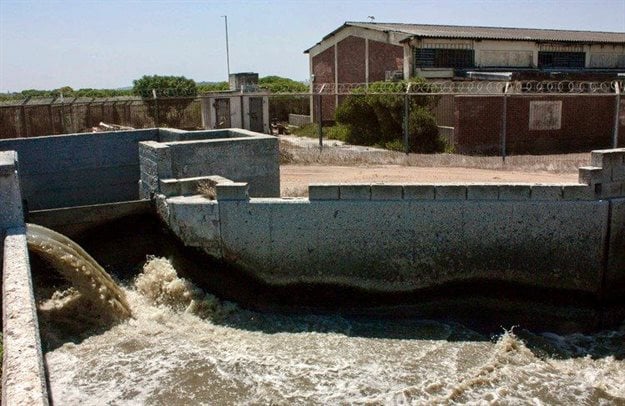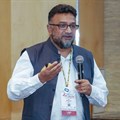The quality of water in Cape Town's rivers has deteriorated to the point where the provincial government has dispatched the Green Scorpions and issued the city with a warning to clean up its act.

Overloading and sub-optimal operation at City waste water treatment works is leading to pollution of Cape Town’s rivers. Water quality tests have failed national guidelines 40% of the time. Photo: Steve Kretzmann/WCN
The city’s water and sanitation department, led by councillor Xanthea Limberg, was given 21 days from 12 February to provide the provincial Department of Environmental Affairs and Development Planning (DEADP) with its short-term, medium-term, and long-term plans to end the ongoing sewage contamination of water bodies.
The warning came after civic bodies complained to the province in December last year, following severe contamination of the Diep River estuary which forms the Milnerton Lagoon.
When GroundUp visited the lagoon at the time, the smell of sewage hung in the air and signs had been posted at the mouth of the lagoon warning the public not to come into contact with the water. Earth-moving equipment had been deployed to dig open the river mouth – which is subject to natural seasonal closures – to allow sea water to dilute the estuary which receives treated effluent from the Postdam wastewater treatment works (WWTW).
'Disturbing results'
At a press conference on Tuesday, 18 February, to announce measures to be taken, DEADP minister Anton Bredell said that after receiving complaints from the public about the state of the Diep River, the Green Scorpions took water samples along the river catchment and Milnerton Lagoon. “The results were disturbing,” he said, with most failing the national guidelines and general authorisation limits for treated wastewater.
He mentioned the 2017 directive ordering the city to clean up unsanitary conditions in Masiphumelele, where he said the city was “implementing its plan effectively”.
The province was not yet at the point of ordering a pre-directive nor directive for the city to clean up its river systems; at this point it was “a letter, failing which the rest will follow”, Bredell’s spokesperson James-Brent Styan clarified in an email.
The new director of water and sanitation in the city, Michael Webster, was tasked with presenting the water quality results at the press conference.
“We acknowledge water quality in the city is poor, and has been for a long time, [but] we’ve reached a tipping point now and have to act,” said Webster as he began his presentation.
Steve Kretzmann 27 Sep 2019 E.coli contamination
Across 21 rivers within the city, 40% of all samples reveal the level of E.coli (a microbiological indicator species for contaminated water) exceeded the national guidelines for non-contact recreational use such as canoeing. Of the samples that failed, 20% were as high as 100 times or more over the limit.
The worst rivers, said Webster, were the Diep River (flowing into Milnerton Lagoon); Disa River in Hout Bay, Salt River, also known as the Black River flowing out at Paarden Eiland; Big Lotus River, Kuils River; and Soet River.
Local scientists have been raising the alarm over the Kuils River for years, with repeated assertions by Limberg that the Zandvliet WWTW, which releases treated effluent into the Kuils River, was not the cause of the problem.
Webster said the dire state of Cape Town’s rivers was due to overloaded treatment plants, sub-optimal operation at treatment plants, power outages at sewage pump stations, and mechanical failures due to an overload of solids.
Sewage spillages
The city is on record stating there are on average 400 sewage spillages across the metro per day, and these, said Webster, were caused by blockages in areas of low gradient such as the Cape Flats, and due to people throwing foreign objects into the system. These spillages flowed into the storm water system discharging into rivers. Fixing these spillages alone cost R250m per year.
He said the 25 WWTWs across the city dealt with 497 megalitres a day, and are designed to deal with 760 megalitres a day.
The quality of effluent released from the WWTW’s met national licensing conditions 80% of the time, which was better than any other metro in South Africa. However, Potsdam treatment works, which discharges into the Diep River, met its license conditions 67% of the time during the course of last year.
A major capital spending programme to upgrade the treatment works was underway, with R11bn committed over ten years. Upgrades at Zandvliet and Potsdam are underway, but the city “recognise[s] there should have been investments earlier in regard to Diep River”, he said.
In the short term, he said the disinfection system at Potsdam treatment works is in urgent need of repair and this will be completed “by April at the latest”.
Potsdam also needs a belt press necessary to remove solids from the water, and this was being procured. Additionally, retention ponds overflowing into the environment were being repaired.
Inspection of business, industry
On a broader scale, the department was “scaling up” the inspection of business and industry effluent; ensuring standby generators at pump stations; increasing the cleaning of canals and culverts; and increasing “cleansing focus” in informal settlements.
The department was also “reviewing the availability of data” following increased public pressure for the city to release the results of its monthly water quality tests conducted at hundreds of points on inland water bodies.
Asked what the reasons were for not releasing water quality data, he said coastal water quality was a “complex system”.
“It is easy to be taken out of context. As residents you want interpreted data to know it is safe to swim.” He failed to explain why river water quality could not be released, saying only: “We’re committed to having greater transparency but also to frame data properly is key.”
Urbanisation, land occupations
Limberg focused on rapid urbanisation and land occupations contributing to pollution of water courses.
Limberg said the 2018/19 year (July to June) saw 87,000 informal structures erected across the city, many in floodplains or stormwater retention areas. In comparison, there were 20,000 informal structures erected the previous financial year.
Bredell said part of the problem the city had to deal with when it came to certain rivers, such as the Diep River, was that their catchment extended beyond the city boundaries. The Diep River for example is also receiving contaminants from agricultural runoff.
He admitted urbanisation had “caught us offside”, noting the city’s population had grown from three million to four million over ten years. This 30% increase was coupled with a decrease in budget grants from national government. Load-shedding had also resulted in sewage spills into river systems as pump stations shut down for hours.
He said while the provincial and local governments worked closely together and, if the city did not deliver on its requirement, the province took a “hard stance”.
“We assure that where the law is broken or where the environment [made] unsafe, we will step in and take action.”
Produced for GroundUp by West Cape News. Article originally published on GroundUp.


























